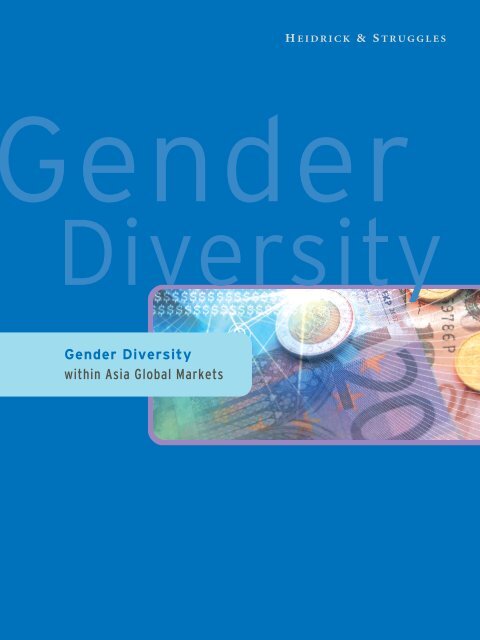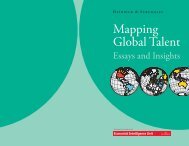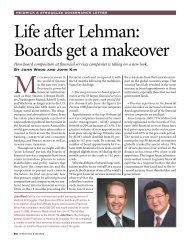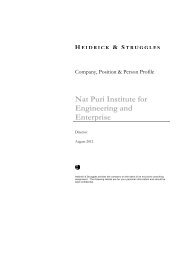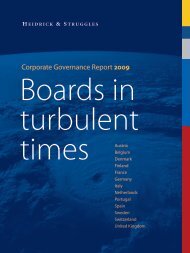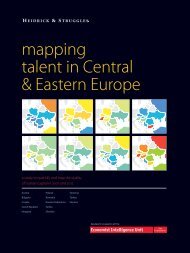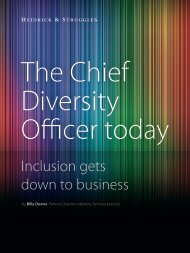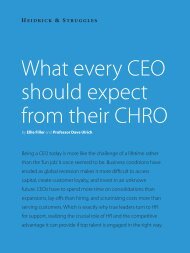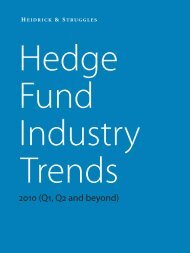Gender Diversity within Asia Global Markets - Heidrick & Struggles
Gender Diversity within Asia Global Markets - Heidrick & Struggles
Gender Diversity within Asia Global Markets - Heidrick & Struggles
Create successful ePaper yourself
Turn your PDF publications into a flip-book with our unique Google optimized e-Paper software.
<strong>Gender</strong> <strong>Diversity</strong><br />
<strong>within</strong> <strong>Asia</strong> <strong>Global</strong> <strong>Markets</strong>
Talk to anyone in a senior management position <strong>within</strong> sales and trading<br />
and they’ll tell you they’re keen to improve the diversity of their organization.<br />
Ask them why and, you get a mixed message generally falling into one of<br />
two camps. For the believers, the main driver is profitability – more diverse<br />
organizations are more productive, have less attrition, more easily attract<br />
top talent, avoid the negative publicity and costs of sex discrimination<br />
court cases and are more attractive to clients. 1 For the skeptics, the driver<br />
is ‘the quota’ – they’ve been told they have to fill a certain quota of senior<br />
positions with women and they want to achieve this goal.<br />
Ultimately, both the believers and the skeptics are driven to the same goal<br />
and at a global management level all the banks have a senior believer<br />
working to redress the balance.<br />
The <strong>Asia</strong> Picture<br />
<strong>Asia</strong> lags behind the more developed economies in terms of the proportion of<br />
women in leadership roles. This is pervasive across all industries. The 2009<br />
World <strong>Gender</strong> Gap Report by the World Economic Forum, shows that women<br />
in <strong>Asia</strong> occupy 25% of senior roles in the region, compared with 38% in France,<br />
Germany, the United Kingdom and the United States collectively. [FIGURE 1]<br />
FIGURE 1: 2009 WEF <strong>Global</strong> <strong>Gender</strong> Gap Report<br />
<strong>Asia</strong> vs US/Europe’s Leading Industrial Economies<br />
70.00%<br />
60.00%<br />
50.00%<br />
40.00%<br />
30.00%<br />
20.00%<br />
10.00%<br />
0.00%<br />
41.66% 46.03%<br />
% of women in<br />
total labor force<br />
38.25%<br />
25.33%<br />
% of women<br />
Managers, Legislators<br />
or Senior Officials<br />
Figure 1 Insert chart from powerpoint<br />
1 GENDER DIVERSITY WITHIN ASIA GLOBAL MARKETS<br />
<strong>Asia</strong> ex-Japan<br />
50.38% 50.50%<br />
% of women<br />
in Professional/<br />
Technical roles<br />
57.11% 64.25%<br />
Average Woman’s pay<br />
as a percentage of<br />
Average Men’s pay<br />
France, Germany, UK, US<br />
Note – Above data does not account for population size per country so is an average of the<br />
percentages per country from the WEF report<br />
Source: World Economic Forum 2009 <strong>Global</strong> <strong>Gender</strong> Gap Report
Within the sales and trading divisions of the major banks in <strong>Asia</strong>, this situation<br />
is exaggerated; women hold, on average, 11% of Managing Director positions<br />
and 18% of Director level positions according to research we conducted with<br />
6 of the region’s leading banks. [FIGURE 2]<br />
FIGURE 2: Percentage of Women in Senior <strong>Global</strong> <strong>Markets</strong> Positions<br />
18.0%<br />
16.0%<br />
14.0%<br />
12.0%<br />
10.0%<br />
8.0%<br />
6.0%<br />
4.0%<br />
2.0%<br />
0.0%<br />
Source: <strong>Heidrick</strong> & <strong>Struggles</strong> surveyed six of the world’s leading Investment Banks to ascertain, on average, what percentage of<br />
senior positions are filled by women<br />
So why is this?<br />
All the banks we spoke with recognize the value that women bring to the bottom<br />
line and most are actively trying to attract more women to the ranks.<br />
<strong>Heidrick</strong> & <strong>Struggles</strong> <strong>Asia</strong> Pacific Research<br />
<strong>Heidrick</strong> & <strong>Struggles</strong> <strong>Asia</strong> Pacific recently conducted a survey to assess the<br />
gender diversity situation in the region by speaking candidly with 22 senior<br />
female executives working in Equity, Fixed Income, Foreign Exchange and<br />
Interest Rates Sales, Trading and Structuring positions. All the women we spoke<br />
with were asked the same set of questions and spoke on condition of anonymity.<br />
The Pitfalls<br />
18%<br />
Directors<br />
A common theme among the women we spoke with is that they are either<br />
excluded or self exclude themselves from the informal social activities preferred<br />
by male colleagues. Most women prefer to spend their time with family and<br />
friends outside of work than watch ‘the game’ or catch up over a beer.<br />
This is a similar story in other industries with a pronounced gender imbalance.<br />
The effects of this are two-fold:<br />
11%<br />
Managing Directors<br />
GENDER DIVERSITY WITHIN ASIA GLOBAL MARKETS 2
In a work hard, play hard culture, it can feel awkward if you want to work<br />
hard, play elsewhere.<br />
By excluding themselves from the majority of social events, women are missing<br />
the opportunity that men have from networking with colleagues which<br />
provides informal feedback and direction on how they can be more effective<br />
at work.<br />
The Positives<br />
The women we spoke with thrive in competitive environments. Yes, they want<br />
to see more women in senior roles but they don’t want to change the culture<br />
of competition to achieve this. The key to success is attracting more women<br />
who fit in rather than changing the culture to attract more women.<br />
All across <strong>Asia</strong>, from Hong Kong and India to Singapore<br />
and Indonesia, women leaders told us that they have been<br />
successful in their careers despite the fact that sales and<br />
trading can be a “Boy’s Club”.<br />
Many commented that they have always been comfortable<br />
in predominantly male environments and, when asked<br />
whether they’d made any significant changes to their style or working practices,<br />
76% of the women surveyed said they hadn’t made any changes that they<br />
wouldn’t have made in a more diverse environment. (i.e. 76% of women surveyed<br />
said that they are naturally able and inclined to succeed in a competitive, male<br />
dominated environment)<br />
The remaining 24% said that they had to speak up/stand up for themselves<br />
more than they would have done if there were more women in the business.<br />
However, none thought they had made any significant changes to their working<br />
style/practices and some commented that they had reverted to their natural style<br />
once they felt they were established in their organization.<br />
So What’s The Point?<br />
All of the women we spoke with want to see more female colleagues in senior<br />
positions. In general, they feel that from a personal perspective, more senior<br />
female colleagues would provide a better support network <strong>within</strong> the organization<br />
and make it easier to socialize with peers. Having more women in senior roles<br />
would also provide junior women with much-needed role models or mentors<br />
3 GENDER DIVERSITY WITHIN ASIA GLOBAL MARKETS<br />
The key to success is<br />
attracting more women<br />
who fit in rather than<br />
changing the culture to<br />
attract more women.
and our respondents feel that this will encourage them to remain committed<br />
to their global markets career, improve retention and break the cycle of attrition.<br />
Finally, all agreed that the ultimate aim of having more senior women is that<br />
it will lead to a more balanced and harmonious working environment which<br />
will aid employee retention, improve performance and profitability.<br />
Engagement And Retention<br />
The women leaders that <strong>Heidrick</strong> & <strong>Struggles</strong> spoke with suggested some<br />
initiatives they felt could help women in <strong>Global</strong> <strong>Markets</strong>.<br />
Early Mentoring<br />
High potential female Vice Presidents should be selected for mentor programs<br />
in order to benefit from informal advice and feedback early on. Men can make<br />
good mentors as they can advise on how to survive and succeed in a predominantly<br />
male environment.<br />
Greater visibility for women role models<br />
It is important for senior women to be visible and accessible, in order to motivate<br />
junior women.<br />
More rounded promotion criteria<br />
One third (32%) of the women surveyed proposed looking into promotion<br />
criteria to establish whether more weight should be given to behaviors,<br />
management ability and corporate citizenship as this may help recognize potential<br />
future leaders who may be otherwise overlooked.<br />
Flexible work schedules<br />
About half (55%) the women surveyed volunteered that they knew of qualified<br />
women who have not been able to find a suitable position in sales and trading<br />
that allowed them to work less than five days a week – a key criteria for them<br />
to return to work.<br />
In addition, some of the existing initiatives at the banks were praised; global<br />
women leadership training programs that help empower high potential women<br />
and create international relationships (e.g. Citi has an established program).<br />
Managing Director annual reviews that include an element of gender diversity<br />
GENDER DIVERSITY WITHIN ASIA GLOBAL MARKETS 4
(hiring/pay/promotion/retention) provide an impetus to make diversity a part<br />
of the bank’s culture and mindset (e.g. an element of Goldman Sach’s MD pay<br />
is linked to diversity). Development sessions on <strong>Diversity</strong> and Leadership that<br />
can help raise awareness of the issues and foster an inclusive culture <strong>within</strong> the<br />
organization (e.g. Deutsche Bank runs these sessions for all its leaders).<br />
Adding The “S” Factor To Mentoring<br />
Many firms have come to recognize that mentoring is an essential way to retain<br />
and develop staff as well as to build a pipeline of talent for the future. Both<br />
mentors and protégés benefit from the mutual professional and leadership skills<br />
development and shared enhanced insight that comes from the establishment<br />
of successful mentoring relationships hence it’s no surprise that this is a powerful<br />
leadership development tool.<br />
However, many organizations have yet to realize<br />
the importance of strengthening mentorship with<br />
sponsorship. It was suggested that mentors who<br />
step forward and use their influence with senior<br />
executives to become advocates for their ‘mentees’<br />
are also their ‘sponsors’. A recent study states that<br />
“high-potential women are over-mentored and<br />
under-sponsored relative to their male peers and<br />
that they are not advancing in their organizations.<br />
Furthermore, without sponsorship, women not only are less likely than men<br />
to be appointed to top roles but may also be more reluctant to go for them.” 2<br />
A recent study states<br />
that “high-potential women<br />
are over-mentored and<br />
under-sponsored relative to<br />
their male peers and that<br />
they are not advancing in<br />
their organizations.”<br />
A First Step<br />
From our research, it is evident that leading women in sales and trading have<br />
been successful because it is the right environment for them, not because they<br />
managed to adapt to the environment. Theoretically then, the solution is simple<br />
– hire more women at entry level who have the natural inclination to thrive in<br />
competitive environments, provide mentoring and sponsorship throughout their<br />
careers and offer flexible work arrangements during the time that they decide<br />
to start their own family.<br />
Unfortunately, in reality, there is no simple solution. This is predominantly<br />
because the pool of candidates considered at entry level are graduates from<br />
mathematics and engineering related university programs which are largely male<br />
5 GENDER DIVERSITY WITHIN ASIA GLOBAL MARKETS
dominated subjects; as an example, only 22% of 2009 UK graduates in<br />
mathematics and engineering related subjects were women. The picture is similar<br />
worldwide. If only one in four of the graduate target pool is female, to make<br />
any significant changes to the gender mix at entry level, the banks would need<br />
to widen the target pool of candidates and look outside of the traditional<br />
mathematics and engineering related subjects. Although not inconceivable, this<br />
approach has its own set of challenges as highly developed mathematics skills<br />
are a pre-requisite for success in the sales and trading environment.<br />
The issue of gender diversity is clearly a complex one and diversity initiatives<br />
take a long time to produce results – at least five years before there is any<br />
significant impact. For an industry that is still recovering from the <strong>Global</strong><br />
Financial Crisis in the full glare of the world’s media, five years is a long time<br />
to wait for results from a change initiative that has only been theoretically proven<br />
to improve profitability.<br />
Although this may sound dampening, even small positive changes made today<br />
will yield results in years to come. It is important for industry leaders to recognize<br />
the advantages of a diverse workforce, understand the unique environment of<br />
the sales and trading world in <strong>Asia</strong> Pacific and ensure suitable steps are taken to<br />
continue attracting and retaining the best available female talent to the industry.<br />
ENDNOTES<br />
1: The theory that a diverse organization is more profitable is supported by research by professors at the<br />
business schools of Columbia University and the University of Maryland. Using data on 1,500 US<br />
companies from 1992 to 2006, Professors Cristian L. Deszo and David Gaddis Ross demonstrated<br />
the “strong positive association between return on assets, and return on equity on the one hand and<br />
the [female top-management] participation rate on the other.”<br />
2: Extracted from a study in Harvard Business Review<br />
ABOUT THE AUTHORS<br />
Harry O’Neill leads the Financial Services Practice in <strong>Asia</strong> Pacific with over 15 years of search experience<br />
in all areas of traded and capital markets as well as investment banking. Voted the “most admired individual<br />
headhunter for debt and global markets searches, <strong>Asia</strong>-wide” for 6 consecutive years in <strong>Asia</strong>money, Harry<br />
is widely recognized as one of the most respected search consultants in <strong>Asia</strong>. Harry is based in Hong Kong<br />
and can be contacted at +852 2103 9300 or honeill@heidrick.com.<br />
Lisa Wong is a senior member of the <strong>Asia</strong> Pacific Financial Services Practice and specializes in the recruitment<br />
of equity cash and derivatives professionals for <strong>Asia</strong> (excluding Japan). A seasoned professional with<br />
over 10 years of search experience under her belt, Lisa is based in Hong Kong and can be contacted at<br />
+852 2103 9300 or lwong@heidrick.com.<br />
Richard Boden is a consultant with <strong>Heidrick</strong> & <strong>Struggles</strong>’ Financial Services Practice in <strong>Asia</strong> Pacific<br />
specializing in executive search assignments for senior sales and trading professionals in the region.<br />
His extensive career in search spans over a decade and includes periods working in London, Sydney and<br />
Hong Kong. During this time, Richard has worked both in executive search and with a global investment<br />
bank leading their recruitment division in <strong>Asia</strong> Pacific. Richard is based in Hong Kong and can be contacted<br />
on +852 2103 9300 or rboden@heidrick.com.<br />
GENDER DIVERSITY WITHIN ASIA GLOBAL MARKETS 6
About <strong>Heidrick</strong> & <strong>Struggles</strong> International, Inc.<br />
<strong>Heidrick</strong> & <strong>Struggles</strong> International, Inc., (Nasdaq:HSII) is the leadership advisory<br />
firm providing senior-level executive search and leadership consulting services,<br />
including succession planning, executive assessment, talent retention management,<br />
executive development, transition consulting for newly appointed executives, and<br />
M&A human capital integration consulting. For almost 60 years, we have focused on<br />
quality service and built strong leadership teams through our relationships with clients<br />
and individuals worldwide. Today, <strong>Heidrick</strong> & <strong>Struggles</strong> leadership experts operate<br />
from principal business centers in North America, Latin America, Europe and <strong>Asia</strong><br />
Pacific. For more information about <strong>Heidrick</strong> & <strong>Struggles</strong>, please visit www.heidrick.com.<br />
AUSTRALIA &<br />
NEW ZEALAND<br />
MELBOURNE<br />
Tel: +61 (3) 9012 3000<br />
SYDNEY<br />
Tel: +61 (2) 8205 2000<br />
AUCKLAND<br />
Tel: +64 (9) 306 6630<br />
WELLINGTON<br />
Tel: +64 (4) 499 5051<br />
INDIA<br />
BANGALORE<br />
Tel: +91 (80) 4256 3000<br />
MUMBAI<br />
Tel: +91 (22) 6666 3021<br />
NEW DELHI<br />
Tel: +91 (12) 4465 5300<br />
JAPAN<br />
TOKYO<br />
Tel: +81 (3) 4520 7800<br />
KOREA<br />
SEOUL<br />
Tel: +82 (2) 3430 6000<br />
SINGAPORE<br />
Tel: +65 6332 5001<br />
TAIWAN<br />
TAIPEI<br />
Tel: +886 (2) 2757 6123<br />
THAILAND<br />
BANGKOK<br />
Tel: +66 (2) 664 1011<br />
P.R. CHINA<br />
BEIJING<br />
Tel: +86 (10) 6598 8288<br />
CHONGQING<br />
Tel: +86 (23) 6300 1588<br />
GUANGZHOU<br />
Tel: +86 (20) 3813 5588<br />
HONG KONG<br />
Tel: +852 2103 9300<br />
SHANGHAI<br />
Tel: +86 (21) 6136 1988<br />
Copyright 2010, <strong>Heidrick</strong> & <strong>Struggles</strong>. All rights reserved. No part of this work may be reproduced<br />
in any form without written permission from the copyright holder.


